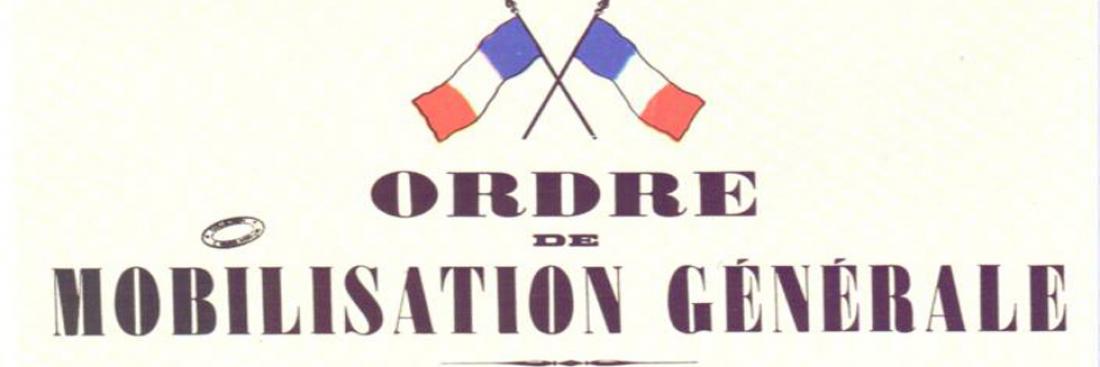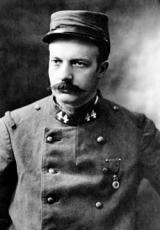La France en guerre 1939 - 1940

Corps 1
FRANCE AT WAR 1939 - 1940
Corps 2
When Adolf Hitler came to power in January 1933, his principal objectives were known: the revision of the treaties for peace and the reunification of the native German people within a single Germany. In March 1935, regardless of the Treaty of Versailles, Germany began a rearmament process. A year later, the Rhineland was remilitarised. Once isolated, the Nazi regime drew closer to Fascist Italy during the Ethiopian war (1935) and the Spanish Civil war (1936) and later to imperialist Japan. Later, the annexation of Austria in 1938 and the seizure of Czechoslovakia, followed by the establishment of a German protectorate in Bohemia and Moravia backed France and Great Britain into a corner against a Germany that was now totally bent on war. In 1939, Adolf Hitler, encouraged by the weakness of the democracies, turned to Poland, demanding the free town of Dantzig. Aware of the dangers and that a confrontation was inescapable, France and Great Britain finally adopted an uncompromising policy, protecting the borders of those countries threatened by the Third Reich: Poland, as well as Romania, the Netherlands and Belgium.
From that situation, the position of the Soviet Union became a deciding factor. The democracies had engaged in negotiations with Stalin, but on the 23rd August 1939, Berlin and Moscow concluded a pact of non-aggression, whose secret protocol planned sharing Poland and the Baltic states (Lithuania, Latvia and Estonia). Great Britain and France had to choose between war and another climb down. On the 28th August the Führer set down some unacceptable demands: notably the handing back of Dantzig and another part of High Silesia to the Reich. In response, Poland instigated general mobilisation. On the 31st Mussolini suggested a conference, but the dice had been cast. At dawn the following day, the Wehrmacht, using an act of aggression as an excuse, attacked Poland. In France, general mobilisation was made official. On the 3rd September 1939, as no response had been forthcoming to the Franco-British ultimatum demanding the withdrawal of German troops, Great Britain at 11 am, followed by France at 5pm, declared war on Germany.
Entrenched along the Maginot line in the East, the French army lay in wait for the hypothetical attacks along the Franco-Belgian border for eight months, subjected to a very harsh winter. The morale of the men, who had nothing to do, declined at the same rate as that of the nation. Strategies and armaments Everything led to believe (...) that in order to win the latest war, all that was required was to avoid the mistakes that almost led to the loss of the previous one and to repeat the methods that had ensured success the first time , Marc Bloch, in L'étrange défaite.
On the 23rd August 1939, General Gamelin confirmed to Edouard Daladier, the President of the Council, that the French army was ready. In fact, it was far from being able to stand up to this war prepared by Hitler and his generals, which was founded on speed, resourcefulness and flexibility. The top French military authorities believed that their defences, considered since the victory of 1918 to be state of the art in terms of military science, were naturally superior to any attack. Banking on a long conflict, it was to them essential to maintain an unassailable continuous front and to await an opportune moment for a decisive counter attack, devised as a lengthy and large-scale operation in which tanks must first ensure the protection of the infantry and carry out reconnaissance and diversionary missions. To comply with this strategy, although the French army had enough armoured tanks and heavy artillery, they did not have the aircraft required to engage in a substantial offensive.
This outlook was consistent and in tune with French public opinion, which was under the guidance of the political classes and still deeply traumatised by the bloodbath of the Great War and by pacifism. However, as Colonel de Gaulle remarked in his book Vers l'armée de métier (1934), this defensive "wait and see" policy behind the Maginot line was not in keeping with the French international security policy founded on alliances in central Europe, especially with Poland. In all logic, such a security system would involve an offensive military tool. The Maginot line, the pillar of the French defensive strategy, was a dense network of concrete casemates that were considered to be unassailable, with barricades and ditches, anti-tank obstacles and underground fortresses.
The line covered the eastern and north eastern borders, from Switzerland as far as Montmédy, i.e. the borders with Germany and Luxembourg; beyond this, the Ardennes forest was believed to be impassable, even for powerful armoured tanks. This defensive system should have made a sudden attack on France impossible and allowed the mobilisation of the land army. Further west, along the border with Belgium, French units would have to improvise a line of defence as an "extension to the Maginot line.
In fact the Maginot line absorbed a large part of the funds allocated to national defence to the detriment of modern weapons, immobilising numerous specialist troops and yet failing to prepare the French army for the shock of modern warfare. The Germans also had their Siegfried line, which was less elaborate and shorter than the Maginot line.
Between 1930 and 1935, French armament programmes gave priority to fortifications and the navy, to the detriment of the land and air forces and industrial mobilisation. Although the period of rearmament from 1935 to1939 allowed the accrual of the same number of tanks as the Nazis, some deficits could not be overcome: anti-tank and anti-air weapons, the means for communication and traversing terrain, as well as individual firearms.
Although the artillery was considerable in number (more than 11,000 canons), half of it consisted of the famous "75" from the First World War, which would soon prove to be outdated against the German 105 mm, but would remain an excellent anti-tank weapon. Even after the Poland campaign, which led to discovering the German tactic of co-ordinated tank, air force and infantry action, the French considered tanks and the air force to be nothing more than support weapons for the infantry, the "queen of battles". Used in small groups, two thirds of the fleet of tanks had to be ready to intervene anywhere along the front. Importantly, though, refuelling them had been inadequately researched. In 1940, the French had around 3,200 tanks and automatic machine guns, the British 600 and the Germans 3,500. Although in terms of the amount and quality of their equipment the Allies could stand up to comparison with the Wehrmacht, it was in their tactical application and especially the combination of tanks and aircraft, General Guderian's favourite, that a very distinct advantage over the German troops would be demonstrated during the campaign in France.
In the Wehrmacht armoured tanks were used in mass formations, with aircraft in support as they breached enemy lines and parachute units seized control of important obstacles. Following German victory in Poland, the French strategy was maintained. It was a matter of gaining time and waiting for the effects of the embargo on Germany, whose economy was in no fit state to sustain a long and widespread conflict. It was also a matter of waiting for the efforts of the rearmament and mobilisation of the Empire to come to fruition; of waiting whilst the British completed their preparation and, finally, of waiting for the Americans to enter into the conflict. Until then, they had to hold out. Faith in the Maginot line and the naval superiority of the Allies favoured this "wait and see" strategy. This outlook on the conflict was not totally without foundation, but the French command confused defence with inaction. It left the initiative to the enemy, whose military power had been overestimated. Indeed, the serious deficiencies of the Wehrmacht in terms of personnel, officers, equipment, raw materials, fuel and ammunition forced Hitler to hope for a quick victory over the military power of the French. "The phoney war"
Everything here is frozen. My controls are frozen. The machine guns are frozen (...) After nine months of war, we still have not managed to get our machine guns and controls adapted to high altitude conditions by the factories responsible, Antoine de Saint Exupéry, war pilot. In France, the "phoney war" was justified by the need to hold out without a hitch until at least the spring of 1940. The allied forces had to step things up, accelerate their military output, consolidate their fortifications and bring the small states into the fold of the Franco-British entente. At the same time, Germany was to start feeling the effects of the embargo, the German people rejecting a regime that was leading them to an impasse, with Italy and the Soviet Union distancing themselves from their ally. The offensive of the Wehrmacht, forced to attack, would be contained and then pushed back. At the end of a conflict lasting several years, the allied counter-attack would be victorious. The refusal to relieve Poland at the beginning of September 1939 was the logic of the French high command: waiting behind the Maginot line, it was not possible to risk the French army from day one in a long conflict with units that were not prepared for the offensive. Moreover, the fate of this war was to be played out, as in 1918, along the north eastern front, on national soil.
In fact, these eight months of passivity were not enough to strengthen allied military prospects. However, Germany, occupying two new countries (Norway and Denmark), had secured its supplies of iron as well as petrol and cereals via the small states of the Soviet Union. For its part, despite her policy of "non-belligerence", Italy declared herself ready to stand alongside Germany. And as for the people and the German generals over whom Hitler had imposed control, they remained united behind their "guide". Despite some progress French military production, which had been disrupted by general mobilisation, had not lived up to expectation, especially where aircraft and anti-tank and anti-air weapons were concerned. Discord arose between the Allies: the French accused the British of not wanting to commit themselves enough on the continent and the Belgians doubted that the Franco-British were capable of protecting them.
In France, the settling of scores accentuated political differences. The banning of the communist party, who supported the Germano-Soviet pact and refused to back an "imperialist conflict" and press campaigns by the right, not just against Germany but also against the Soviet Union for attacking Finland in November, made the situation worse. Unlike in 1914, there was no sacred union. The French entered into the war not only with resignation, but also with steadfastness. However, the long months of the "phoney war" rendered the army inactive and affected the people, worn down by twenty years of pacifism and in whom a defeatist current surfaced, made worse by the Polish surrender. It had been thought that once Poland had been beaten, peace was possible. France was not attacked: there was no danger to the nation as there had been in 1914. Doubts began to enter about the meaning of the war. Some were hoping for a new "Munich".
In addition, discontentment took over the people, shocked by the special postings, the problems of everyday life and the increase in the cost of living. At the front, the soldiers, with nothing to do, were becoming bored. On returning from visiting troops, Albert Lebrun, The President of the Republic, admitted having encountered some "weakened wills and relaxed discipline". The slowness of mobilisation, delays in setting up the heavy artillery for attacking the German fortifications, the Polish defeat and especially Gamelin's desire to "manage manpower wisely" and not "blunt the tool" all explain the behaviour of the Generalissimo, who refused to take advantage of an extremely favourable situation.


